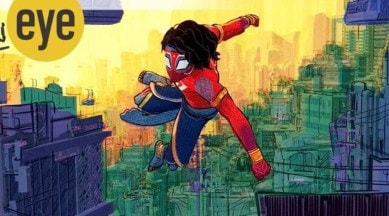📣 For more lifestyle news, click here to join our WhatsApp Channel and also follow us on Instagram
Sunday Long Reads: How an Indian Spider-Man became a sensation, Shubhra Gupta on 25 years of Satya, and more
Here are this week's most interesting reads!

How an Indian Spider-Man, Pavitr Prabhakar, swung across our screens and became a sensation six decades after the original Spider-Man
It’s Mumbai. It’s Manhattan. It’s Mumbattan.
monthly limit of free stories.
with an Express account.
That magnificent amalgamation of New York City and Mumbai is the friendly neighbourhood of Pavitr Prabhakar, the Indian Spider-Man who swung onto the big screen with Spider-Man: Across the Spider-Verse last month. The smash-hit animation film — a follow-up to 2018’s Academy Award-winning Into the Spider-Verse — was released theatrically in India in 10 languages, including English, Hindi, Tamil, Telugu, Malayalam, Gujarati, Marathi and Bengali.
Why colouring one’s hair is more than just being platinum blonde
Why would a grown man, a consummate professional, a restless, creative culinarian, an avid reader, a hungry gourmand, a busy mentor to several young adults, a 24/7 bathroom singer, and a daydreamer with boundless vision torment himself by bleaching his hair? Why would someone, anyone, put themselves through an ordeal as cumbersome, painful, and challenging as stripping dark-dark hair down to platinum blonde? What makes someone impossible to cage in even the freest of spaces willingly surrender to a six- plus-hour process that seems interminable?
What makes this new book on living in a kotha, a gripping tale
The life of a courtesan is not a new subject. We know who they are, how they dress, their demeanour, and we imagine their lives in our heads. There have been movies and web series that tell their stories. So, when Mumbai-based author-script writer Manish Gaekwad’s book ‘The Last Courtesan — Writing My Mother’s Memoir’ (HarperCollins India; 499) was released earlier this week, one wondered how different would this one be?
Shubhra Gupta on 25 years of Satya: Bullets over Bollywood
This song, a colloquial curveball from the venerable Gulzar, set to music by Vishal Bhardwaj. The picturisation, featuring grubby hoods from the Mumbai underworld, clumsily throwing their hands and feet around. The film, Ram Gopal Varma’s Satya, which ushered in such a monumental change in Indian cinema that we are still assessing its impact, 25 years after it came out.
My friendly neighbourhood red-whiskered bulbuls
For many years, a pair of lissome red-whiskered bulbuls did duty as my alarm call, perched on the tangled bougainvillea creeper just outside my bedroom window. They were sensible birds, not going by our clocks but quite simply by sunrise or dawn time. All it took were a couple of mellifluous calls, and I’d be awake — it was so much pleasanter than being awoken by a smartphone alarm.
On his 133rd birth anniversary, a look at the contributions of Dhan Gopal Mukerji, the first Indian to win the prestigious Newbery Medal
Since the last few years, questions of identity and representation have taken centre stage in pop culture discourses across the globe. The Indian diaspora has also been swept up in these discussions — from romance novels to Marvel movies to British TV shows, people of Indian descent have been demanding not just representation for its sake alone, but a seat at the table, an active acknowledgement of their contributions to culture.
What makes Kashmiri band Alif such a sensation
The composition Kya Karie Korimol (What will the bride’s father do?), in Hindustani and Koshur, recently made it to the ongoing Coke Studio Bharat. The otherwise underwhelming series found attention last month when 40-year-old musician Mohammad Muneem Nazir, aka Alif, created the piece in collaboration with Aashima Mahajan, a Dogra musician from Jammu, and Kashmiri folk singer Noor Mohammad.
📣 For more lifestyle news, click here to join our WhatsApp Channel and also follow us on Instagram